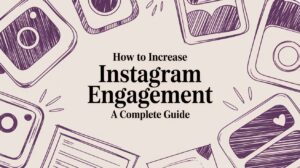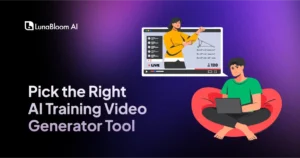Trying to find the right AI video creation tools in today’s crowded market can feel like searching for a needle in a haystack. These platforms promise to slash production time, cut costs, and make video creation accessible to everyone. But how do you choose the right one for you?
Whether you’re a marketer needing to create ads at scale, an educator building engaging courses, or a small business owner aiming to level up your social media, the best tool depends on your specific goals, technical skills, and budget.
This guide cuts through the noise. We’ll give you a practical, hands-on review of the leading platforms, looking beyond the hype to see how they perform in the real world. You’ll get a clear breakdown of features, realistic use cases, honest pros and cons, and transparent pricing.
Our goal is simple: to give you the insights you need to make an informed choice. We’ll cover everything from text-to-video and AI avatars to advanced editing. While we focus on a curated list, you can explore a broader landscape of options by checking out this resource on other AI video creation tools. By the end, you’ll know exactly which AI video tool will best supercharge your content creation.
1. LunaBloom AI
LunaBloom AI stands out as a top-tier choice among AI video creation tools, offering a powerful yet incredibly user-friendly platform to turn text and images into professional-grade videos. Its intuitive design is all about efficiency, allowing you to generate high-quality content for marketing, education, or social media in minutes—no editing experience required. The platform’s main strength is delivering studio-quality results with minimal effort, making it a game-changer for creators and businesses.
What really makes LunaBloom AI different is its full suite of features built for global content. The platform supports over 50 languages with more than 150 natural-sounding AI voices, which you can personalize further with advanced voice cloning. This is a massive advantage for businesses aiming to create authentic, localized content that truly connects with international audiences.
Key Features and Use Cases
- Customizable AI Avatars: Choose from a wide range of photo-realistic, animated, and 3D avatars, or create your own custom one to keep your brand consistent. This is perfect for corporate training videos, product explainers, and social media updates.
- Multilingual Voice Synthesis: Automatically generate lifelike voiceovers in dozens of languages. An educator could create multilingual versions of their lessons, or a marketing team could adapt a single campaign for multiple regions without any extra fuss.
- Automated Subtitles and Translation: The platform automatically generates and translates subtitles, which is crucial for accessibility and boosting SEO on platforms like YouTube. It simplifies reaching a wider, more inclusive audience.
- Brand Customization: Easily add your own logos, color schemes, and fonts to every video. This ensures all your communications look professional and cohesive.
Pricing and Accessibility
LunaBloom AI offers a flexible pricing model. A free starter plan lets you explore the core features on a pay-as-you-go basis. For more intensive use, subscription plans unlock advanced features like voice cloning, full HD exports, and more video creation capacity, providing scalable options for everyone from freelancers to large enterprises.
2. Synthesia
Synthesia has carved out a special place among ai video creation tools by focusing on professional, presenter-led videos. It excels at turning text into polished presentations with AI avatars, making it a favorite for corporate training, internal comms, and personalized sales videos. Instead of a complicated timeline, you work with a simple, slide-based interface—just type your script, and the AI presenter does the rest.
The real magic of Synthesia is its enterprise-readiness and powerful localization features. With over 120 languages and accents, companies can scale their video content globally without the headache of reshooting with different actors. You can even create custom, hyper-realistic avatars to have a consistent digital spokesperson that matches your brand perfectly.
Key Features & User Experience
Synthesia’s browser-based editor is incredibly intuitive, requiring almost no video editing experience. You pick an avatar, type your script, add a background or screen recording, and you’ve got a professional video.
- Presenter-Centric Model: Offers over 125 diverse stock AI avatars or the option to create a custom digital twin of yourself.
- Powerful Localization: Generate videos with voiceovers in numerous languages, including the ability to automatically translate and dub existing video scripts.
- Collaboration & Branding: Features like shared workspaces, custom brand kits (fonts, colors, logos), and SSO integration are designed for team and enterprise workflows.
Pricing and Use Case
Synthesia’s pricing is built for business users. The personal plan starts at $22/month (billed annually) and includes 10 minutes of video credit. Higher-tier plans for creators and enterprises offer more minutes, custom avatars, and advanced collaboration tools.
Best For:
- Corporate L&D: Quickly creating training and onboarding materials.
- Sales & Marketing: Generating personalized video pitches at scale.
- Global Businesses: Localizing marketing and communication videos efficiently.
Limitations: The platform’s greatest strength is also its main weakness. It’s not designed for cinematic storytelling or action-packed videos; the output is always a presenter speaking to the camera.
3. HeyGen
HeyGen has quickly become a popular choice among ai video creation tools by offering an accessible yet powerful platform for generating AI avatar videos. It strikes a great balance between ease of use and professional quality, making it a go-to for sales, marketing, and L&D teams who need to produce content fast. The platform’s diverse avatar library and robust voice cloning and translation features are its core strengths.
What makes HeyGen stand out is its generous free tier and user-friendly, template-driven workflow. This allows individuals and small teams to experiment with AI video before committing to a paid plan. Its ability to create “talking photos” from a single image or generate custom avatars provides a versatile toolkit for everything from social media updates to personalized client messages.
Key Features & User Experience
HeyGen’s web-based editor is built for speed and simplicity. You can choose from hundreds of templates and avatars, paste your script, and customize scenes with text, images, and music—all in a clean, intuitive interface.
- Diverse Avatar Options: Choose from over 100 stock AI avatars, create a custom avatar, or animate a static photo to create a unique “talking photo” video.
- AI-Powered Localization: Supports over 40 languages with high-quality AI voiceovers and one-click video translation and dubbing.
- Template-Rich Library: Speed up production with pre-made templates designed for various use cases like social media, training, and sales pitches.
- Team Collaboration: Business plans offer shared workspaces, asset management, and team seats for streamlined content creation workflows.
Pricing and Use Case
HeyGen offers a very accessible entry point with a free plan that includes 1 minute of video credit. Videos have a watermark, but it’s a great way to start. Paid plans start at $24/month (billed annually) for the Creator plan, which removes the watermark and provides more credits.
Best For:
- Content Creators & Marketers: Quickly producing engaging social media content.
- Sales Teams: Creating personalized video outreach at scale.
- Educators & Trainers: Developing instructional videos and L&D modules.
Limitations: While the free tier is great for testing, the watermark is a deal-breaker for professional use. You’ll need to upgrade to a paid plan to unlock the best features and higher-quality video resolutions.
4. Runway
Runway has established itself as a professional-grade creative suite among ai video creation tools, appealing to artists, filmmakers, and advanced users. It goes beyond simple text-to-video, offering a full set of “AI Magic Tools” for video-to-video, rotoscoping, inpainting, and motion tracking. With its focus on granular control and cutting-edge models like Gen-2, it’s a powerhouse for experimental and high-end video projects.
What truly sets Runway apart is its blend of generative AI with a more traditional, timeline-based video editor. This allows you to not only generate new clips from text or images but also to composite, edit, and refine them alongside existing footage. The platform is built for serious creative work, bridging the gap between a raw AI concept and a polished final product.
Key Features & User Experience
Runway’s web interface feels like a futuristic video editor. It offers a suite of powerful, distinct tools that can be used together to achieve complex visual effects. The learning curve is steeper than simpler tools, but it rewards you with unparalleled creative freedom.
- Advanced Generative Models: Features text-to-video (Gen-2), image-to-video, and video-to-video, allowing for diverse and artistic transformations.
- Comprehensive Editing Suite: Includes a multi-track editor, green screen removal, motion tracking, and 3D texture generation, all powered by AI.
- High-Quality Output: Higher-tier plans support 4K exports and ProRes/PNG sequence downloads, catering to professional production workflows.
Pricing and Use Case
Runway operates on a credit-based system, with a free plan offering a small number of credits. The Standard plan starts at $12 per user/month (billed annually) with 625 credits. An “Unlimited” plan offers full, albeit potentially slower, generation access for a flat fee.
Best For:
- Filmmakers & Artists: Creating experimental films and visual effects.
- Creative Agencies: Developing unique and visually striking ad concepts.
- VFX Professionals: Augmenting workflows with AI-powered tools like rotoscoping.
Limitations: The credit system can be unpredictable for budgeting large projects. The Unlimited plan might slow down your workflow with queues during peak times, and mastering the advanced features requires a real time investment.
5. Luma AI Dream Machine
Luma AI has quickly made a name for itself in the ai video creation tools space with its Dream Machine, a model focused on producing high-quality, photorealistic video clips from text and image prompts. The platform is designed for creators who prioritize cinematic quality and natural character motion, making it a powerful tool for generating short-form content, conceptual visuals, and dynamic b-roll footage that feels incredibly lifelike.
What makes Dream Machine stand out is its impressive understanding of physics and fluid motion. This results in videos that have a high degree of realism and consistency, something many other text-to-video generators struggle with. Its focus on advanced rendering, including HDR options, delivers professional-grade output for demanding creative projects where visual quality is everything.
Key Features & User Experience
The interface is minimalist and prompt-focused, inviting you to generate clips with very little setup. The platform clearly communicates its credit-based system, showing the cost of each generation based on the model, resolution, and desired length.
- Advanced Rendering: Offers multiple “Ray” models with options for HDR and upscaling up to 4K, providing superior visual fidelity.
- Credit-Based System: A transparent usage model where users pay per generation, with clear breakdowns of credit costs before creating a clip.
- Commercial Licensing: Paid plans (Plus and above) grant users a commercial license, allowing the use of generated content in professional projects without watermarks.
Pricing and Use Case
Luma AI offers a free tier with a limited number of monthly credits, but the videos are watermarked and non-commercial. Paid plans start at $29.99/month for the Standard tier, which provides more credits and removes the watermark. Higher tiers offer significantly more credits and priority generation access.
Best For:
- Filmmakers & Artists: Creating high-quality concept art and pre-visualization shots.
- Marketing Agencies: Generating unique, eye-catching visuals for social media campaigns.
- Content Creators: Producing short, cinematic clips to enhance video projects.
Limitations: The main drawback is the short length of the generated clips, usually capped at 5-10 seconds. This makes it better for creating supplementary footage rather than full-length stories directly on the platform.
6. Pika
Pika has quickly become a powerful player among ai video creation tools, known for its speed and creative flexibility. It lets you generate and edit videos from text, images, or even other video clips, offering a versatile set of features for everything from artistic shorts to dynamic social media content. The platform’s real appeal is its granular control, allowing you to modify specific areas of a video, expand its canvas, or change aspect ratios with simple text commands.
What sets Pika apart is its transparent, credit-based system and the choice between different AI models. You can use a fast ‘Turbo’ model for quick drafts or a higher-quality ‘Pro’ model for final renders. This flexibility, combined with API access, makes Pika a highly adaptable tool for both individual creators and developers looking to integrate AI video into their applications.
Key Features & User Experience
Pika’s interface is designed for creative experimentation. It has a simple prompt bar but includes advanced options for fine-tuning camera motion, aspect ratios, and applying effects. This balance makes it accessible for beginners while providing depth for experienced users.
- Multi-Modal Generation: Create videos from text, images, or by modifying existing videos (video-to-video).
- Granular Credit System: Offers clear per-feature costs, allowing you to manage your budget based on the complexity of your creations.
- Flexible Creative Tools: Features include canvas expansion, region modification (“Modify Region”), and tools for face swaps and asset replacement.
- API Access: Provides an API for developers to build custom integrations, though currently limited to 720p resolution output.
Pricing and Use Case
Pika uses a tiered, credit-based pricing model. A free tier is available with watermarked videos. Paid plans, starting with the Standard plan at $8/month (billed annually), give you a monthly credit allowance, remove the watermark, and unlock commercial usage rights.
Best For:
- Social Media Creators: Quickly generating eye-catching short-form video content.
- Artists & Animators: Experimenting with generative video for creative projects.
- Developers: Integrating AI video features into third-party applications via API.
Limitations: The credit system means that complex, high-resolution generations can get pricey. Access to 1080p and 4K video depends on the model you use and your credit balance.
7. Descript
Descript revolutionizes video editing by treating it like a text document, making it one of the most intuitive ai video creation tools for content-heavy projects. Instead of fiddling with complex timelines, you can edit your footage by simply deleting words from the automatically generated transcript. This unique, text-based approach is a game-changer for podcasters, educators, and marketers, dramatically speeding up the workflow.
What truly sets Descript apart is its all-in-one “record, transcribe, edit, mix” philosophy. The platform combines screen recording, transcription, AI-powered filler word removal (“um,” “uh”), and a stunningly realistic voice cloning feature called Overdub. This lets you fix audio mistakes by just typing the correct word, all within a single app. No more jumping between different software tools!
Key Features & User Experience
Descript’s interface is clean and centered around the transcript, making video editing as easy as editing a doc. The AI tools are seamlessly integrated to automate tedious tasks, letting you focus on the story.
- Text-Based Video Editing: Cut, copy, paste, and delete parts of your video by editing the text transcript. The video timeline updates automatically.
- Overdub AI Voice: Correct audio errors or add new narration by typing text, using a realistic clone of your own voice.
- Studio Sound: A one-click AI effect that removes background noise and enhances voice quality to a professional, studio-like level.
- Automated Filler Word Removal: Instantly find and remove all instances of “ums,” “ahs,” and other filler words from your recording.
Pricing and Use Case
Descript offers a free plan with limited transcription. Paid plans start with the Creator tier at $12/month (billed annually), which unlocks more transcription hours and removes watermarks. The Pro plan at $24/month provides unlimited Overdub and other advanced features.
Best For:
- Podcasters & YouTubers: Editing long-form interviews and talking-head videos quickly.
- Content Repurposing: Easily creating short social media clips from longer videos.
- Corporate Trainers: Producing polished tutorials and e-learning content.
Limitations: While powerful for dialogue-driven content, Descript isn’t designed for complex visual effects or cinematic sequences. Its strength is in AI-assisted editing, not full text-to-video generation.
8. Kapwing
Kapwing positions itself as a fast, accessible, and collaborative online video editor packed with practical AI features. It’s one of the most versatile ai video creation tools for social media managers and content creators who need to quickly edit, subtitle, and repurpose videos right in their browser. The platform blends a traditional timeline editor with a suite of one-click AI tools, streamlining otherwise tedious workflows.
What makes Kapwing stand out is its focus on content repurposing and accessibility. You can automatically generate subtitles, translate them, remove backgrounds, and use text-to-speech without downloading any software. This all-in-one approach, combined with team collaboration features, makes it a powerful hub for marketing teams looking to maintain a high-volume presence across multiple social platforms.
Key Features & User Experience
Kapwing’s interface is clean and user-friendly, feeling more like a lightweight design tool than a complex video suite. The AI tools are integrated directly into the editing workflow, making them easy to find and use.
- AI-Powered Subtitling & Translation: Automatically transcribe video audio and translate it with high accuracy, tracking usage by the minute.
- Content Repurposing Tools: Features like AI B-Roll Finder, auto-resizing for different social formats, and a video-to-article generator maximize the value of each piece of content.
- Team Collaboration: Offers shared workspaces, brand kits for consistent branding (colors, logos, fonts), and cloud storage for seamless team projects.
- High-Quality Exports: Unlike many browser-based editors, Kapwing supports exports up to 4K resolution on its paid plans.
Pricing and Use Case
Kapwing offers a free plan with a watermark, making it great for casual use. The Pro plan, starting at $16/month (billed annually), removes the watermark, unlocks 4K exports, and provides a generous allowance of subtitling minutes and AI credits.
Best For:
- Social Media Managers: Quickly resizing and subtitling content for TikTok, Reels, and Shorts.
- Content Creators: Editing vlogs and tutorials with automated tools.
- Marketing Teams: Collaborating on promotional videos and maintaining brand consistency.
Limitations: Being entirely browser-based, the platform can sometimes struggle with very long or complex projects, especially on less powerful computers. The free plan’s watermarks are a major drawback for professional use.
9. VEED
VEED has positioned itself as an all-in-one online video suite, integrating a powerful set of ai video creation tools into a single, accessible platform. It’s perfect for users who need more than just generation, offering a complete workflow from creation to final polish. VEED is designed for marketers, trainers, and content creators who want to produce professional-grade videos without the steep learning curve of traditional software.
What makes VEED a standout choice is its comprehensive feature set that covers the entire video production lifecycle. You can generate videos from text, create AI avatars, and then seamlessly move into a full-featured editor to add subtitles, remove background noise, apply brand kits, and even correct eye contact. This end-to-end capability simplifies the creation process, eliminating the need to jump between multiple apps.
Key Features & User Experience
VEED’s browser-based interface is clean and user-friendly, successfully blending advanced AI features with a traditional timeline editor. This hybrid approach makes it approachable for beginners while still offering the control that experienced creators expect.
- Comprehensive AI Toolset: Includes text-to-video, AI avatars, automatic subtitles, voice cloning, and AI-powered noise removal.
- Full-Fledged Editor: Beyond AI generation, it offers a complete editing suite with transitions, text effects, stock media, and brand kits.
- One-Click Enhancements: Features like eye-contact correction and background removal streamline post-production tasks.
- Collaboration & Hosting: Provides tools for team collaboration and options for video hosting and sharing directly from the platform.
Pricing and Use Case
VEED offers a free plan with watermarked exports and limited features. Paid plans start with the Basic tier at $12/month (billed annually), which removes the watermark and unlocks more features. Pro and Business plans offer access to the full suite of AI tools and advanced branding options.
Best For:
- Social Media Managers: Quickly creating and repurposing content with auto-subtitles.
- Marketing Teams: Producing polished promotional videos and product demos.
- Corporate Trainers: Developing engaging training materials with AI presenters and clean audio.
Limitations: The most powerful AI features are locked behind higher-tier subscription plans. While versatile, it may not replace dedicated desktop editors for highly complex, multi-layered projects.
10. InVideo
InVideo positions itself as a comprehensive, workflow-driven platform among ai video creation tools, designed specifically for marketers and content creators. It streamlines the entire process from script to finished video with a powerful AI engine, offering pre-made templates, an extensive stock media library, and AI-powered voiceovers. Its approach is perfect for users who need to produce social media content, ads, and promotional videos quickly without a steep learning curve.
What makes InVideo stand out is its clear, credit-based system and its focus on marketing-centric workflows. Instead of unlimited generation, plans offer specific quotas for video minutes, AI generation credits, and iStock media usage. This structure allows teams to manage and budget their content creation efforts precisely, making it a predictable and scalable solution for businesses.
Key Features & User Experience
InVideo’s user interface is built around guided workflows. You input a script or idea, and the AI generates a full video storyboard, complete with scenes, media, and text.
- Guided Script-to-Video: An intuitive AI workflow that transforms text prompts into a complete video sequence, selecting relevant stock footage and generating voiceovers automatically.
- Credit & Quota System: Plans come with specific allotments for AI generation, video export minutes, and premium iStock media, providing clear usage tracking.
- AI Avatars & Voices: Includes options to add AI presenters and generate voiceovers from text, though with fewer options than specialized avatar platforms.
Pricing and Use Case
InVideo offers a free plan with watermarked exports. Paid plans, starting with the Plus plan at $20/month (billed annually), remove watermarks and provide larger quotas for video minutes, iStock media, and storage. The Max plan offers significantly more credits for power users.
Best For:
- Social Media Managers: Quickly creating engaging video content from articles or ideas.
- Marketers: Producing video ads and promotional content with branded templates.
- Small Businesses: Generating professional-looking videos on a predictable budget.
Limitations: The credit and minute quotas on lower-tier plans require careful management. The free plan is quite restrictive, serving mainly as a trial of the platform’s core features.
11. Adobe Express with Generate Video (Firefly)
Adobe brings its creative suite power into the world of ai video creation tools with Adobe Express, powered by its Firefly generative AI model. This platform is designed as an all-in-one content creation tool, integrating text- and image-to-video capabilities into a user-friendly editor. It’s positioned not just as a standalone tool but as a key part of the broader Adobe ecosystem, offering a seamless on-ramp to professional apps like Premiere Pro.
What sets Adobe Express apart is its focus on creating commercially safe content and its deep integration with professional-grade software. You can quickly generate short clips from text prompts, use advanced animation tools, and remove video backgrounds, all within a single interface. This makes it an excellent choice for creators who need to produce high-quality social media content quickly but also want a pathway to more advanced post-production work.
Key Features & User Experience
Adobe Express provides a smooth, intuitive experience on both mobile and web, making it highly accessible. The AI features are powered by a credit system, allowing you to experiment with generative video based on your plan.
- Integrated Adobe Ecosystem: Offers a smooth workflow for sending projects to Adobe Premiere Pro or After Effects for advanced editing and finishing touches.
- Generative AI by Firefly: Includes text-to-video for generating short clips and features like AI-powered background removal and animation presets.
- Brand & Team Features: Supports brand kits for consistency and offers plans tailored for enterprise and educational institutions.
- Commercially Safe Content: Firefly is trained on Adobe Stock and openly licensed content, reducing the risk of copyright issues for business use.
Pricing and Use Case
Adobe Express offers a free plan with limited Firefly credits. The Premium plan, around $9.99/month, provides more credits and premium features. Pricing can vary by region and is often bundled with other Adobe Creative Cloud subscriptions.
Best For:
- Social Media Managers: Quickly creating branded video content and animations.
- Adobe Creative Cloud Users: Extending their workflow with quick, AI-powered video generation.
- Small Businesses: Producing marketing videos without needing advanced editing skills.
Limitations: The text-to-video generation is still in its early stages and is best for creating short, simple clips. The AI credit system means high-volume generation can become costly.
12. G2
While not a creation tool itself, G2 is an indispensable resource in the ai video creation tools ecosystem. It’s a massive B2B software marketplace and review platform where you can compare different AI video generators based on real-world user feedback. For businesses doing their homework, G2 provides an unbiased layer of validation that cuts through the marketing hype.
What makes G2 so valuable is its detailed, side-by-side comparison feature. You can filter tools by company size, user satisfaction ratings, and specific features to create a shortlist of vendors that truly match your needs. Instead of relying on a vendor’s claims, G2 offers crowd-sourced insights into usability, support quality, and the actual pros and cons experienced by everyday users. It’s a critical step before making any purchase.
Key Features & User Experience
G2’s platform is designed for research and comparison, allowing you to quickly assess the competitive landscape and find the best-fit solution.
- Verified User Reviews: Access hundreds of in-depth reviews and ratings from authenticated users, providing honest feedback on various AI video tools.
- Comparison Grids: Directly compare up to four different platforms side-by-side, evaluating them on features, pricing models, and satisfaction scores.
- Advanced Filtering: Narrow down the vast market by industry, business size, language support, and other specific criteria to find relevant options quickly.
Pricing and Use Case
Accessing reviews and comparison data on G2 is completely free for buyers. The platform makes money through vendor listings, so you can conduct your research without a subscription.
Best For:
- Pre-Purchase Research: Evaluating and comparing different AI video platforms before committing.
- Marketers & Agencies: Finding tools that meet specific client or campaign requirements.
- Enterprise Teams: Validating vendor claims and ensuring a tool fits enterprise-level workflows.
Limitations: The platform is a research aggregator, not a creation tool. Some user reviews may be incentivized, so it’s wise to read a variety of opinions and not rely on a single review.
AI Video Creation Tools Feature Comparison
| Platform | Core Features ✨ | User Experience ★★★★☆ | Value & Pricing 💰 | Target Audience 👥 | Unique Selling Points 🏆 |
|---|---|---|---|---|---|
| LunaBloom AI 🏆 | 50+ languages, customizable AI avatars, voice cloning, auto subtitles | Intuitive UI, fast video creation | Free starter, scalable plans | Creators, marketers, educators, businesses | Photo-realistic avatars, multilanguage voice cloning, affordability |
| Synthesia | 125+ AI avatars, brand kits, multilingual dubbing | Fast turnaround, enterprise features | Credit-based, tier caps | Business, training, localization | Presenter-led style, team collaboration |
| HeyGen | 500+ avatars, voice cloning, web editor | Easy use, good quality | Free tier with limits, paid advanced | Sales, marketing, L&D teams | Generous free tier, interactive avatars |
| Runway | Gen-3/4 text-to-video, 4K export, credit system | Creative controls, transparent pricing | Credit plans including unlimited | Creative professionals, educators | Cutting-edge AI models, ProRes export |
| Luma AI Dream Machine | HDR, 4K upscaling, credit usage | High-fidelity, realistic motion | Credit-based, commercial licenses | Photorealistic workflows | Strong realism, smooth motion |
| Pika | Multiple AI models, API access | Fast iteration, granular pricing transparency | Credit system, watermark-free paid tiers | Developers, creatives | Turbo mode, variety of effects |
| Descript | Text-based video editing, voice overdubbing | Easy for tutorials, podcasts | Subscription-based, plan limits | Podcasters, educators, content repurposers | Text-doc style editing, Overdub voice clone |
| Kapwing | Auto-subtitles, translation, 4K exports | Social media focused, team workspace | Usage minutes tracked, free plan limits | Social creators, teams | Batch processing, clear plan limits |
| VEED | Text-to-video, noise removal, brand kits | Easy onboarding, comprehensive toolkit | Subscription plans vary | Marketers, training video creators | Noise removal, eye-contact correction |
| InVideo | Script-to-video, avatars, stock media | Marketer-friendly templates | Credit & quota system | Marketers, social media creators | Stock+avatar combos, clear usage quotas |
| Adobe Express (Firefly) | AI credits, background removal, animation tools | Pro workflow integration | AI credits vary by plan | Professionals, enterprises | Adobe ecosystem integration |
| G2 | User reviews, ratings, feature comparisons | Independent feedback source | Free | Buyers, researchers | Verified user reviews, comparison marketplace |
Final Thoughts
The world of video production has been completely transformed by AI video creation tools. What used to require a huge budget, technical skills, and tons of time is now available to creators of all levels. From generating hyper-realistic avatars to turning text prompts into cinematic clips, the platforms we’ve explored are changing the game.
Tools like Synthesia and HeyGen are revolutionizing corporate training and marketing with polished avatar videos, removing the need for traditional filming. At the same time, generative powerhouses like Runway, Luma AI, and Pika are pushing creative boundaries, letting filmmakers and artists bring abstract ideas to life in ways we could only dream of before.
For the everyday content creator or small business owner, platforms like Descript, VEED, and InVideo have integrated AI to streamline the most annoying parts of video editing. These tools make the process more intuitive and creative, with features like automatic transcription and filler word removal that save countless hours.
Key Takeaways for Choosing Your Tool
Picking the right platform from this list of AI video creation tools can seem tough. Let your goals, comfort level with tech, and budget be your guide.
- For High-Fidelity Avatars: If you need professional, consistent video messaging with digital humans for training or marketing, Synthesia and HeyGen are the clear winners.
- For Creative and Artistic Generation: If you want to create unique, visually stunning videos from text or images, Runway, Luma AI, and Pika offer the most advanced creative tools.
- For All-in-One Editing and Content Repurposing: If you need a complete suite to edit existing footage, repurpose content for social media, and use AI enhancements, Descript, Kapwing, and VEED are fantastic, user-friendly options.
- For Template-Driven Speed: When speed is key for creating marketing or social media videos, InVideo and Adobe Express have vast template libraries powered by smart AI.
Final Considerations Before You Commit
Before you choose a tool, think about your workflow. Consider integrations, collaboration features, and the learning curve. Most importantly, remember that these tools are enablers—they don’t replace a strong creative vision. Your strategy should dictate the tool, not the other way around.
Ultimately, AI video creation tools are part of a bigger digital strategy. To see how they fit into a full campaign, check out the top AI marketing software. Embracing these technologies empowers you to produce better content more efficiently, connect with your audience in new ways, and stay ahead in a fast-changing digital world. The revolution is here; the only question is how you’ll use it to tell your story.






